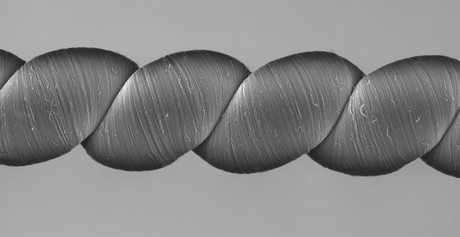'Twistron' yarns can generate electricity

An international research team has developed high-tech yarns that generate electricity when they are stretched or twisted. And before you ask: no, we’re not spinning you a yarn.
Named ‘twistron’ yarns by the research team, which includes scientists from the US, South Korea and China, the yarns are constructed from carbon nanotubes, which are hollow cylinders of carbon 10,000 times smaller in diameter than a human hair. They are described by the researchers in the journal Science.
“The easiest way to think of twistron harvesters is, you have a piece of yarn, you stretch it and out comes electricity,” said co-lead author Dr Carter Haines, from the Alan G. MacDiarmid NanoTech Institute at The University of Texas at Dallas.
The researchers first twist-spun the nanotubes into high-strength, lightweight yarns. To make the yarns highly elastic, they introduced so much twist that the yarns coiled like an over-twisted rubber band. In order to generate electricity, the yarns must be either submerged in or coated with an ionically conducting material, or electrolyte, which can be as simple as a mixture of ordinary table salt and water.
“Fundamentally, these yarns are supercapacitors,” said Dr Na Li, a research scientist at the NanoTech Institute and co-lead author of the study. “In a normal capacitor, you use energy — like from a battery — to add charges to the capacitor. But in our case, when you insert the carbon nanotube yarn into an electrolyte bath, the yarns are charged by the electrolyte itself. No external battery, or voltage, is needed.”
When a harvester yarn is twisted or stretched, the volume of the carbon nanotube yarn decreases, bringing the electric charges on the yarn closer together and increasing their energy, explained Dr Haines. This increases the voltage associated with the charge stored in the yarn, enabling the harvesting of electricity.
Stretching the coiled twistron yarns 30 times a second generated 250 W/kg of peak electrical power when normalised to the harvester’s weight, said Dr Ray Baughman, director of the NanoTech Institute and a corresponding author of the study.
“Although numerous alternative harvesters have been investigated for many decades, no other reported harvester provides such high electrical power or energy output per cycle as ours for stretching rates between a few cycles per second and 600 cycles per second,” Dr Baughman said.
In the lab, the researchers showed that a twistron yarn weighing less than a housefly could power a small LED, which lit up each time the yarn was stretched. They also demonstrated that twistrons can harvest waste thermal energy from the environment, with Dr Li connecting a twistron yarn to a polymer artificial muscle that contracts and expands when heated and cooled. The twistron harvester converted the mechanical energy generated by the polymer muscle to electrical energy.
“There is a lot of interest in using waste energy to power the Internet of Things, such as arrays of distributed sensors,” Dr Li said. “Twistron technology might be exploited for such applications where changing batteries is impractical.”
The researchers also sewed twistron harvesters into a shirt. Normal breathing stretched the yarn and generated an electrical signal, demonstrating its potential as a self-powered respiration sensor. As noted by Dr Baughman, “Our yarns produced over a hundred times higher electrical power per weight when stretched compared to other weaveable fibres reported in the literature.”
Having demonstrated that their energy harvesters worked using table salt as an electrolyte, Dr Baughman revealed that the next step was to “show that they would also work in ocean water, which is chemically more complex”.
In a proof-of-concept demonstration, co-lead author Dr Shi Hyeong Kim, a postdoctoral researcher at the NanoTech Institute, waded into the surf off the east coast of South Korea to deploy a coiled twistron in the sea. He attached a 10 cm-long yarn, weighing only 1 mg, between a balloon and a sinker that rested on the seabed. Every time an ocean wave arrived, the balloon would rise, stretching the yarn up to 25%, thereby generating measured electricity.
Even though the investigators used very small amounts of twistron yarn in their study, they have already shown that harvester performance is scalable, both by increasing twistron diameter and by operating many yarns in parallel. Dr Baughman revealed, “If our twistron harvesters could be made less expensively, they might ultimately be able to harvest the enormous amount of energy available from ocean waves.
“However, at present these harvesters are most suitable for powering sensors and sensor communications. Based on demonstrated average power output, just 31 mg of carbon nanotube yarn harvester could provide the electrical energy needed to transmit a 2 KB packet of data over a 100 m radius every 10 seconds for the Internet of Things.”
Unlocking next-gen chip efficiency
By studying how heat moves through ultra-thin metal layers, researchers have provided a...
Ancient, 3D paper art helps shape modern wireless tech
Researchers have used ancient 3D paper art, known as kirigami, to create tuneable radio antennas...
Hidden semiconductor activity spotted by researchers
Researchers have discovered that the material that a semiconductor chip device is built on,...






